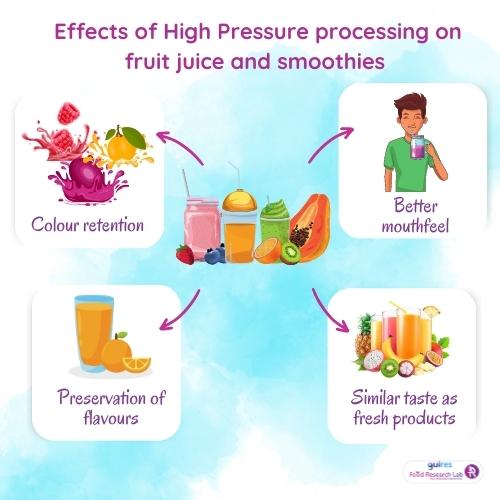
How does High-Pressure Processing affect the sensory quality of fruit juices and smoothies?
Introduction
Fruits and vegetables have been considered necessary in the human diet and are often called ‘protective foods.’ However, they are susceptible to losing quality since some are seasonal, and some have a shorter shelf-life. Various processing methods have been implemented to increase their shelf-life; thermal methods are the most common. However, this method often deteriorates the quality of fruit-based beverages and affects their sensory characteristics like taste, colour and flavour. Nutrient loss was also observed using traditional methods of beverage processing. Therefore, innovations in beverage processing techniques were made. High-pressure processing (HPP) is one such innovation that is rapidly gaining popularity [1].
HPP achieves the effects of pasteurisation without heating, and its effects on macromolecules and flavour compounds are significantly lesser than thermal processing. In addition, studies have shown that HPP preserves the aroma of fresh fruit juices, making them highly acceptable among consumers. Therefore, the beverage industries seek to incorporate HPP in fruit juice processing.
Studies focussing on the effect of HPP on the sensory perception of beverages
A study was conducted by Song et al., determining how the processing technique impacted the sensory profile of orange juice and apple juice. Thermal- and High-pressure processing techniques were used in the fruit beverages, and the sensory testing was carried out among sensory panellists and consumers. It was noted that the temperature, time and treatment significantly influenced the sensory profile of the juice. In the case of orange juice, high-pressure processing was associated with visible fruit pulp, real fruit juice flavours and fruit pulp mouthfeel. In contrast, HPP was associated with a yellow-brown colour and cloudy appearance in apple juice. However, the flavour profile was better in HPP-treated orange and apple juice, making them more acceptable among consumers [2].
Sarantakou et al. studied how the quality of avocado puree-based smoothie was affected by HPP, thermal processing and no processing. Polyphenyl oxidase (PPO) is an enzyme which causes browning in avocados. The study revealed that High-Pressure Processing inactivates PPO, and treatment using the optimum pressure for a stipulated time resulted in the smoothie being more ‘Fresh-like’ avocado characteristics with a bright green colour, creamy texture and a natural avocado flavour. In addition, avocados processed using HPP also had a higher retention of Vitamin C, implying that HPP can be used as a non-thermal processing method that retains the quality of avocado smoothie [3].
A comparison of the processing of mango smoothies was conducted by Bi et al. It was observed that the smoothie treated under a fixed pressure did not significantly increase the viscosity of the smoothie, making it more ‘fresh-like’ and increasing consumer acceptability. Also, this pressure led to the least deterioration in total carotenoid content, making the smoothie more visually appealing among consumers [4].
Another study was conducted on the effect of HHP on a fermented pomegranate beverage. It was observed that the antioxidant content was increased in HHP-treated beverages. In contrast, the content of the natural colour, anthocyanin, was retained, unlike thermally processed beverages, where there was a deterioration of the colour. However, no difference in taste was noted [5].

Fig 1: High pressure processing on juices and smoothies
The above studies indicate that High Pressure Processing or HPP of fruit juices and smoothies was associated with colour retention, better mouthfeel and taste. However, the pressure for processing the fruits were different and one cannot say that a fixed measure of pressure applied yield the same results for all fruits.
Conclusion
Fruit juices and smoothies treated with the High-Pressure Processing technique retained colour and had more natural flavour than thermally processed ones. In addition, they can also give rise to a smoother mouthfeel. However, it is crucial to note that the pressure values and time differ depending on the type of beverage formulated and the fruits used, and the beverage formulators must be cautious in using HPP.
How the Food Research Lab can help
The Food Research Lab is a global contract R&D facility that offers beverage formulation services for clients worldwide. The Lab has a team of experts who assist with choosing the right ingredients, developing a high-quality beverage with excellent sensory characteristics and product labelling that complies with international regulations, ensuring the product formulated is successful.





